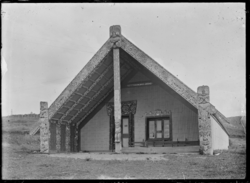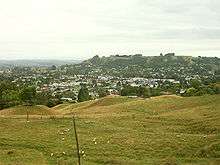Te Kuiti
Te Kuiti is a town in the north of the King Country region of the North Island of New Zealand. It lies at the junction of State Highways 3 and 30 and on the North Island Main Trunk railway, 80 kilometres (50 mi) south of Hamilton. At the 2001 census it had a resident population of 4,374, a decrease of 5.1% since 1991. The town promotes itself as the sheep shearing capital of the world and is host to the annual New Zealand National Shearing Championships.
Te Kuiti | |
|---|---|
 Te Tokanganui-A-Noho meeting house in Te Kuiti, 1917 | |
 Te Kuiti Te Kuiti's location within the North Island | |
| Coordinates: 38°20′S 175°10′E | |
| Country | New Zealand |
| Region | Waikato |
| Territorial authority | Waitomo District |
| Population (June 2019)[1] | |
| • Total | 4,680 |
| Postcode(s) | 3910 |
Te Kuiti is approximately 80 km south of Hamilton and 19 km south-east of Waitomo. The area around Te Kuiti, commonly known as the King Country, gives its name to the Heartland Championship rugby team based in Te Kuiti.
History and culture
Te Kuiti is the Maori name given to the area. In its original form of "Te Kuititanga", it literally means "the valley", "the squeezing in" or "the narrowing".[2]
Several marae are located in and around Te Kuiti, associated with Maniapoto hapū:[3][4]
- Te Kumi Marae and Te Korapatu meeting house are affiliated with Peehi and Rōrā
- Mōtītī Marae and Ko te Hungaiti or Hapainga meeting house are affiliated with Kinohaku, Putaitemuri and Tauhunu
- Te Piruru Papakainga Marae and Te Pukenui o Taonui meeting house are affiliated with Rōrā
- Tāne Hopuwai Marae and Tāne Hopuwai meeting house are affiliated with Apakura
- Te Tokanganui a Noho Marae and meeting house are affiliated with Rōrā
- Tomotuki Marae and Parekatini meeting house are affiliated with Apakura, Parekaitini and Rōrā
- Te Waipatoto Marae, and Waipatoto and Waipatoto Tuarua meeting houses, are affiliated with Kinohaku
Tourism
The "Shearing Capital of the World" contains the world's largest shearer, seven metres high. On 1 April 2006 the largest sheep show in the world took place here, with more than 2000 sheep.[5]


The carved Te Tokanganui-A-Noho Meeting House was gifted to the local Maori people (Ngāti Maniapoto) by Te Kooti, the most famous Maori Rebel leader of the 19th century. He was given sanctuary by the Chiefs of Maniapoto against the white colonial Government of New Zealand and under Maniapoto's protection carved one of the most famous and important late 19th century spiritual house in the north island.(as mentioned above). This House is central to Te Kuiti's historical foundation, also referred to as the epicenter of the Rohe Pōtae.. "King Country"...In 1881 the last frontier was open to colonial settlers.
The Tatsuno Japanese Garden is at the southern end of the main street.[6]
The Mangokewa reserve located 5 km south of Te Kuiti is a popular attraction for rock climbers, hikers, picnic goers, swimmers and trout fisherman in the region.[7]
A 'Revitalisation Project' for the NZHPT Category II listed[8] Te Kuiti railway station was started in 2014[9] to provide for arts and crafts groups, an education centre, youth projects, historical displays and a meeting room.[10] The Rail Heritage Trust describes the station as, "the finest remaining example of a standard class B station".[11]
Geography
Limestone deposits and water have created the Waitomo Caves, northwest of the town, one of New Zealand's most-visited tourist locations. The town itself is located in a valley with many rich limestone deposits.[12] The Manga-o-Kewa Stream runs through the valley and is a tributary of the Waipa River.[13] Te Kuiti's hinterland consist mainly of farmland and limestone quarries. The land surrounding Te Kuiti has steep hilly relief which reflects the nature of the North King Country region. The climate of Te Kuiti is wet during the winter and dry during the late summer with an average of 1,450mm of rainfall each year.[14]
Sport
Te Kuiti is the home of the Waitete Rugby Football Club and the King Country Rugby Union, both of whom are based at Rugby Park. The famous Colin Meads spent the entirety of his career with both Waitete and King Country. The town also has an association football club, Te Kuiti Albion Football Club, who play in the Deacon Shield tournament. They play their home games at Centennial Park where there is a small clubroom. The club colours are yellow and black striped shirts and black shorts.
Education
Te Kuiti has six schools:
- Te Kuiti Primary School is a co-educational state primary school,[15] with a roll of 324 as of March 2020.[16][17]
- Pukenui School is a co-educational state primary school,[18] with a roll of 150.[19]
- Centennial Park School is a co-educational state primary school,[20] with a roll of 65.[21]
- St Joseph's Catholic School is a Catholic state integrated primary school,[22] with a roll of 115.[23]
- Te Kuiti High School is a co-educational state secondary school,[24][25] with a roll of 292.[26]
- Te Wharekura o Maniapoto is a co-educational state Māori immersion school,[27] with a roll of 122.[28]
Notable people
- Ross Beever, geneticist and mycologist.
- Former Prime Minister of New Zealand Jim Bolger held the local electorate of King Country.[29]
- All Black Kevin Boroevich[30]
- Walter Broadfoot (1881–1965), cabinet minister for the National Party, was first deputy mayor and then mayor of Te Kuiti (1923–1935)[31]
- World Champion Sheep Shearer David Fagan[32]
- Murray Kidd, Former rugby union coach for the Irish national team (1995-1997).
- Tony Martin, Australia-based comedian and author, was born here.[33]
- All Black Sir Colin Meads lived in Te Kuiti. The auction of his farm in 2008 caused nationwide interest.[34] A statue of Meads was unveiled in the town centre during the 2017 British and Irish Lions tour to New Zealand, also drawing national interest, and Meads was present and spoke at the unveiling despite battling cancer,[35] which he died from two months later.[36]
- Colin Meads's brother Stanley Meads also lived in Te Kuiti.
- Les Munro, the last surviving pilot from the Dambusters air raid, was mayor for some years and has a street named in his honour.[37]
- Author Ruth Park grew up here.
- Kevin Proctor - Gold Coast Titans, Rugby League player
- Rob Waddell, Olympic gold-medalist rower, was born here.
- Rodney Bell, contemporary dancer, was born here.
- Diggeress Te Kanawa, a tohunga raranga (master weaver) of Ngati Maniapoto and Ngati Kinohaku descent.
References
- "Subnational Population Estimates: At 30 June 2019". Statistics New Zealand. 22 October 2019. Retrieved 11 January 2020.
- Te Kuiti in An Encyclopaedia of New Zealand (1966)
- "Te Kāhui Māngai directory". tkm.govt.nz. Te Puni Kōkiri.
- "Māori Maps". maorimaps.com. Te Potiki National Trust.
- Television NZ News. 1 April 2006
- "Things to see and do in Te Kuiti, New Zealand". www.newzealand.com.
- "Waitomo - parks". Archived from the original on 2 June 2010.
- "Search the List - Te Kuiti Railway Station - Heritage New Zealand". www.heritage.org.nz.
- "Railway Station Buildings Revitalisation Project - Waitomo District Council". www.waitomo.govt.nz.
- "Waitomo News 23 August 2012" (PDF).
- "Rail Heritage Trust of New Zealand - Te Kuiti Station". www.railheritage.org.nz.
- Taonga, New Zealand Ministry for Culture and Heritage Te Manatu. "4. – Rock, limestone and clay – Te Ara Encyclopedia of New Zealand". www.teara.govt.nz.
- "Mangaokewa Stream fishing-Mangaokewa Stream trout fishing-nzfishingv". www.nzfishing.com.
- Environment Waikato Archived 14 October 2008 at the Wayback Machine
- "Te Kuiti Primary School Ministry of Education School Profile". educationcounts.govt.nz. Ministry of Education.
- "New Zealand Schools Directory". New Zealand Ministry of Education. Retrieved 26 April 2020.
- "Te Kuiti Primary School Education Review Office Report". ero.govt.nz. Education Review Office.
- "Pukenui School Ministry of Education School Profile". educationcounts.govt.nz. Ministry of Education.
- "Pukenui School Education Review Office Report". ero.govt.nz. Education Review Office.
- "Centennial Park School Ministry of Education School Profile". educationcounts.govt.nz. Ministry of Education.
- "Centennial Park School Education Review Office Report". ero.govt.nz. Education Review Office.
- "St Joseph's Catholic School Ministry of Education School Profile". educationcounts.govt.nz. Ministry of Education.
- "St Joseph's Catholic School Education Review Office Report". ero.govt.nz. Education Review Office.
- "Te Kuiti High School Official School Website". tkhs.school.nz.
- "Te Kuiti High School Ministry of Education School Profile". educationcounts.govt.nz. Ministry of Education.
- "Te Kuiti High School Education Review Office Report". ero.govt.nz. Education Review Office.
- "Te Wharekura o Maniapoto Ministry of Education School Profile". educationcounts.govt.nz. Ministry of Education.
- "Te Wharekura o Maniapoto Education Review Office Report". ero.govt.nz. Education Review Office.
- Bassett, Michael. "Profile". Archived from the original on 9 March 2012. Retrieved 31 January 2008.
- kevin Boroevich at AllBlacks.com
- Gustafson, Barry (1986). The First 50 Years : A History of the New Zealand National Party. Auckland: Reed Methuen. p. 301. ISBN 0-474-00177-6.
- Noted. "New Zealand Listener - Noted". Noted.
- "Copping a Bad Egg - theage.com.au". www.theage.com.au.
- "Meads farm makes $1.4m at auction retrieved January 2008".
- Hamilton, Tom (19 June 2017). "'Welcome to Meadsville' - New Zealand honours Sir Colin Meads". ESPN (UK). Retrieved 19 June 2017.
- "All Blacks legend Colin Meads dies". ESPN (UK). AAP. 19 August 2017. Retrieved 20 August 2017.
- "Hawke's Bay Today". NZ Herald.
External links
| Wikivoyage has a travel guide for Te Kuiti. |
| Wikimedia Commons has media related to Te Kuiti. |